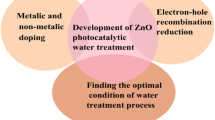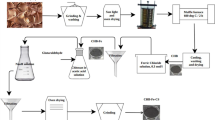Abstract
Calcium and magnesium ions usually exist in natural water. When Cd2+ is removed from water by adsorption, it will be inhibited by these two ions. Titanate nanotubes (TNTs) have an effective adsorption capacity for Cd2+ due to extraordinary ion exchange property. However, TNTs also adsorb Ca2+ and Mg2+ in water. In this study, carbon-modified TNT (TNT/C) and TNT/C further treated with acid (TNT/HC) were synthesized by hydrothermal synthesis. The transmission electron microscope (TEM) images show that TNT/C or TNT/HC still keep nanotube morphology. The experimental results show the order of adsorption amount to Cd2+ is TNT (171.56 mg/g) > TNT/C (166 mg/g) > TNT/HC (159.88 mg/g) when there is no Ca2+ or Mg2+. But when there is 0.1 M Ca2+ or Mg2+ in the water, the order of Cd2+ adsorption capacity becomes TNT/HC (44.28, 49.04 mg/g) > TNT/C (58.84, 69.32 mg/g) > TNT (65.52, 70.6 mg/g). It indicates that the surface carbon modification can alleviate the hindrance of Ca2+ or Mg2+ to Cd2+ removal. This is because the carbon on the surface of TNT captured part of Ca2+ or Mg2+; it made more Cd2+ be successfully absorbed by TNT through ion exchange. This mechanism was confirmed by the X-ray photoelectron spectroscopy (XPS) spectra analysis. The results of this paper can provide ideas for the adsorption and removal of Cd2+ in water in the presence of Ca2+ or Mg2+.










Similar content being viewed by others
Availability of data and materials
All data generated or analyzed during this study are included in this published article.
References
Bi J, Huang X, Wang J, Tao Q, Wang T, Hao H (2020) Titanate for water remediation: synthesis, application, mechanism and optimization. J Mater Chem A 8:14415–14440
Bilal M, Ihsanullah I, Ul Hassan Shah M, Younas M (2021) Enhanced removal of cadmium from water using bio-sorbents synthesized from branches and leaves of Capparis decidua and Ziziphus mauritiana. Environ Technol Innov 24:101922
Bolisetty S, Peydayesh M, Mezzenga R (2019) Sustainable technologies for water purification from heavy metals: review and analysis. Chem Soc Rev 48:463–487
Boparai HK, Joseph M, O’Carroll DM (2011) Kinetics and thermodynamics of cadmium ion removal by adsorption onto nano zerovalent iron particles. J Hazard Mater 186:458–465
Dalvand A, Khoobi M, Nabizadeh R, Ganjali MR, Gholibegloo E, Mahvi AH (2018) Reactive dye adsorption from aqueous solution on HPEI-modified Fe3O4 nanoparticle as a superadsorbent: characterization, modeling, and optimization. J Polym Environ 26:3470–3483
Di Natale F, Gargiulo V, Alfe M (2020) Adsorption of heavy metals on silica-supported hydrophilic carbonaceous nanoparticles (SHNPs). J Hazard Mater 393:122374
Dolatyari L, Yaftian MR, Rostamnia S (2016) Removal of uranium(VI) ions from aqueous solutions using Schiff base functionalized SBA-15 mesoporous silica materials. J Environ Manage 169:8–17
Du AJ, Sun DD, Leckie JO (2011) Sequestration of cadmium ions using titanate nanotube. J Hazard Mater 187:401–406
Duan J, Ji H, Xu T, Pan F, Liu X, Liu W, Zhao D (2021) Simultaneous adsorption of uranium(VI) and 2-chlorophenol by activated carbon fiber supported/modified titanate nanotubes (TNTs/ACF): effectiveness and synergistic effects. Chem Eng J 406:126752
Esrafili L, Firuzabadi FD, Morsali A, Hu ML (2021) Reuse of predesigned dual-functional metal organic frameworks (DF-MOFs) after heavy metal removal. J Hazard Mater 403:123696
Huang X, Zhao H, Hu X, Liu F, Wang L, Zhao X, Gao P, Ji P (2020b) Optimization of preparation technology for modified coal fly ash and its adsorption properties for Cd(2). J Hazard Mater 392:122461
Huang K, Lv X, Guan X, Liu J, Li S, Song H (2020a) Advanced Cd (II) adsorbent fabricated with hordein from barley (Hordeum vulgare L.) via electrospinning technology. Ind Crops Prod 152:112543
Ihsanullah A-K, Abusharkh B, Khaled M, Atieh MA, Nasser MS, laoui T, Saleh TA, Agarwal S, Tyagi I, Gupta VK, (2015) Adsorptive removal of cadmium(II) ions from liquid phase using acid modified carbon-based adsorbents. J Mol Liq 204:255–263
Kasuga T, Hiramatsu M, Hoson A, Sekino T, Niihara K (1998) Formation of titanium oxide nanotube. Langmuir 14:3160–3163
Kim D-W, Wee J-H, Yang C-M, Yang KS (2020) Efficient removals of Hg and Cd in aqueous solution through NaOH-modified activated carbon fiber. Chem Eng J 392:123768
Li X, Liu W, Ni J (2015) Short-cut synthesis of tri-titanate nanotubes using nano-anatase: Mechanism and application as an excellent adsorbent. Microporous Mesoporous Mater 213:40–47
Li G, Zhang J, Liu J, Sun C, Yan Z (2020) Adsorption characteristics of white pottery clay towards Pb(II), Cu(II), and Cd(II). Arab J Geosci 13:519
Li A, Zhang Y, Ge W, Zhang Y, Liu L, Qiu G (2021) Removal of heavy metals from wastewaters with biochar pyrolyzed from MgAl-layered double hydroxide-coated rice husk: Mechanism and application. Bioresour Technol 126425–126425
Liu W, Wang T, Borthwick AGL, Wang Y, Yin X, Li X, Ni J (2013) Adsorption of Pb2+, Cd2+, Cu2+ and Cr3+ onto titanate nanotubes: competition and effect of inorganic ions. Sci Total Environ 456–457:171–180
Liu W, Sun W, Han Y, Ahmad M, Ni J (2014) Adsorption of Cu(II) and Cd(II) on titanate nanomaterials synthesized via hydrothermal method under different NaOH concentrations: role of sodium content. Colloids Surf A Physicochem Eng Aspects 452:138–147
Liu C, Wang P, Liu X, Yi X, Liu D, Zhou Z (2019) Ultrafast removal of cadmium(II) by green cyclodextrin metal-organic-framework-based nanoporous carbon: adsorption mechanism and application. Chem Asian J 14:261–268
Lu F, Astruc D (2018) Nanomaterials for removal of toxic elements from water. Coord Chem Rev 356:147–164
Ma J, Li F, Qian T, Liu H, Liu W, Zhao D (2017) Natural organic matter resistant powder activated charcoal supported titanate nanotubes for adsorption of Pb(II). Chem Eng J 315:191–200
Mahdavi S, Jalali M, Afkhami A (2013) Heavy metals removal from aqueous solutions usinG TiO2, MgO, AND Al2O3 nanoparticles. Chem Eng Commun 200:448–470
Maroto-Valer MM, Dranca I, Lupascu T, Nastas R (2004) Effect of adsorbate polarity on thermodesorption profiles from oxidized and metal-impregnated activated carbons. Carbon 42:2655–2659
Mudhoo A, Ramasamy DL, Bhatnagar A, Usman M, Sillanpaa M (2020) An analysis of the versatility and effectiveness of composts for sequestering heavy metal ions, dyes and xenobiotics from soils and aqueous milieus. Ecotoxicol Environ Saf 197:110587
Pyrzyńska K, Bystrzejewski M (2010) Comparative study of heavy metal ions sorption onto activated carbon, carbon nanotubes, and carbon-encapsulated magnetic nanoparticles. Colloids Surf A Physicochem Eng Aspects 362:102–109
Quiroga-Flores R, Noshad A, Wallenberg R, Onnby L (2020) Adsorption of cadmium by a high-capacity adsorbent composed of silicate-titanate nanotubes embedded in hydrogel chitosan beads. Environ Technol 41:3043–3054
Sriram G, Kigga M, Uthappa UT, Rego RM, Thendral V, Kumeria T, Jung HY, Kurkuri MD (2020) Naturally available diatomite and their surface modification for the removal of hazardous dye and metal ions: a review. Adv Colloid Interface Sci 282:102198
Wang T, Liu W, Xiong L, Xu N, Ni J (2013a) Influence of pH, ionic strength and humic acid on competitive adsorption of Pb(II), Cd(II) and Cr(III) onto titanate nanotubes. Chem Eng J 215–216:366–374
Wang T, Liu W, Xu N, Ni J (2013b) Adsorption and desorption of Cd(II) onto titanate nanotubes and efficient regeneration of tubular structures. J Hazard Mater 250–251:379–386
Wang Q, Lei X, Pan F, Xia D, Shang Y, Sun W, Liu W (2018) A new type of activated carbon fibre supported titanate nanotubes for high-capacity adsorption and degradation of methylene blue. Colloids Surf A Physicochem Eng Aspects 555:605–614
Wang R, Chen H, Xiao Y, Hadar I, Bu K, Zhang X, Pan J, Gu Y, Guo Z, Huang F, Kanatzidis MG (2019) Kx[Bi4-xMnxS6], design of a highly selective ion exchange material and direct gap 2D semiconductor. J Am Chem Soc 141:16903–16914
Wang Z, Wu S, Zhang Y, Miao L, Zhang Y, Wu A (2020) Preparation of modified sodium alginate aerogel and its application in removing lead and cadmium ions in wastewater. Int J Biol Macromol 157:687–694
Wang F, Wu P, Shu L, Huang D, Liu H (2021) High-efficiency adsorption of Cd(II) and Co(II) by ethylenediaminetetraacetic dianhydride-modified orange peel as a novel synthesized adsorbent. Environ Sci Pollut Res Int. https://doi.org/10.1007/s11356-021-17501-7
Xiong L, Chen C, Chen Q, Ni J (2011) Adsorption of Pb(II) and Cd(II) from aqueous solutions using titanate nanotubes prepared via hydrothermal method. J Hazard Mater 189:741–748
Yang X, Guo N, Yu Y, Li H, Xia H, Yu H (2020) Synthesis of magnetic graphene oxide-titanate composites for efficient removal of Pb(II) from wastewater: performance and mechanism. J Environ Manag 256:109943
Yuan F, Wu C, Cai Y, Zhang L, Wang J, Chen L, Wang X, Yang S, Wang S (2017) Synthesis of phytic acid-decorated titanate nanotubes for high efficient and high selective removal of U(VI). Chem Eng J 322:353–365
Yuan S, Hong M, Li H, Ye Z, Gong H, Zhang J, Huang Q, Tan Z (2020) Contributions and mechanisms of components in modified biochar to adsorb cadmium in aqueous solution. Sci Total Environ 733:139320
Yusuf M, Song K, Geng S, Fazhi X (2020) Adsorptive removal of anionic dyes by graphene impregnated with MnO2 from aqueous solution. Colloids Surf A Physicochem Eng Aspects 595:124667
Zhang S, Cui M, Chen J, Ding Z, Wang X, Mu Y, Meng C (2019) Modification of synthetic zeolite X by thiourea and its adsorption for Cd (II). Mater Lett 236:233–235
Zhang J, Hou D, Shen Z, Jin F, O'Connor D, Pan S, Ok YS, Tsang DCW, Bolan NS, Alessi DS (2020) Effects of excessive impregnation, magnesium content, and pyrolysis temperature on MgO-coated watermelon rind biochar and its lead removal capacity. Environ Res 183:109152
Zhao G, Li J, Ren X, Chen C, Wang X (2011) Few-layered graphene oxide nanosheets as superior sorbents for heavy metal ion pollution management. Environ Sci Technol 45:10454–10462
Zhao X, Cai Z, Wang T, O’Reilly SE, Liu W, Zhao D (2016) A new type of cobalt-deposited titanate nanotubes for enhanced photocatalytic degradation of phenanthrene. Appl Catal B 187:134–143
Zhao F, Yang Z, Wei Z, Spinney R, Sillanpää M, Tang J, Tam M, Xiao R (2020) Polyethylenimine-modified chitosan materials for the recovery of La(III) from leachates of bauxite residue. Chem Eng J 388:124307
Zheng C, Wu Q, Hu X, Wang Y, Chen Y, Zhang S, Zheng H (2021) Adsorption behavior of heavy metal ions on a polymer-immobilized amphoteric biosorbent: surface interaction assessment. J Hazard Mater 403:123801
Zhou G, Luo J, Liu C, Chu L, Crittenden J (2018) Efficient heavy metal removal from industrial melting effluent using fixed-bed process based on porous hydrogel adsorbents. Water Res 131:246–254
Zhou Y, Li Y, Liu D, Wang X, Liu D, Xu L (2020) Synthesis of the inorganic-organic hybrid of two-dimensional polydopamine-functionalized titanate nanosheets and its efficient extraction of U(VI) from aqueous solution. Colloids Surf A Physicochem Eng Aspects 607:125422
Zhu J, Liu Q, Li Z, Liu J, Zhang H, Li R, Wang J (2018) Efficient extraction of uranium from aqueous solution using an amino-functionalized magnetic titanate nanotubes. J Hazard Mater 353:9–17
Funding
The project gets the funding support from the National Natural Science Foundation of China (No. 21676137 and No. 21838004).
Author information
Authors and Affiliations
Contributions
Mingda Wu: conceptualization, methodology, sample preparation, writing–original draft. Linghong Lu: supervision, writing, validation. Tao Zhou: data curation, calculation, Yi Ma: investigation, drawing. Zhengsong Weng: reviewing, editing.
Corresponding author
Ethics declarations
Ethics approval and consent to participate
Not applicable.
Consent for publication
Not applicable.
Conflict of interest
The authors declare no competing interests.
Additional information
Responsible Editor: Angeles Blanco
Publisher's note
Springer Nature remains neutral with regard to jurisdictional claims in published maps and institutional affiliations.
Rights and permissions
About this article
Cite this article
Wu, M., Lu, L., Zhou, T. et al. Removal of Cd2+ from water containing Ca2+ and Mg2+ using titanate nanotubes modified by carbon. Environ Sci Pollut Res 29, 44794–44805 (2022). https://doi.org/10.1007/s11356-022-19002-7
Received:
Accepted:
Published:
Issue Date:
DOI: https://doi.org/10.1007/s11356-022-19002-7




